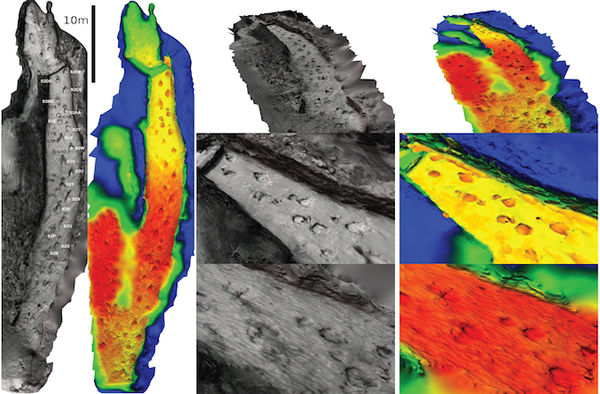Deadly Dinosaur Chase Reconstructed
A set of prehistoric footprints, said to show meat-eating dinosaurs hunting vegetarian dinos, has just been recreated in a detailed 3-D model.
The frozen-in-time event, dated to at least 112 million years ago, happened at what is now the Paluxy River site in Dinosaur Valley State Park near the town of Glen Rose, Texas — just southwest of Fort Worth.
The chase involved 20 to 30-foot-long predatory dinosaurs going after 30 to 50-foot-long dinosaur prey. While paleontologists aren’t yet certain of the species, Acrocanthosaurus (aka “High-spined Lizard”) is considered the likely hunter and Pleurocoelus (a hefty and impressively huge plant eater) the hunted.
It looks like one or more big predatory dinosaurs was stalking a herd of about 12 sauropods before the hunters went in for the kill. Some have suggested the tracks show one or more dinosaurs dying, since the footprints of young sauropods (the plant eaters) appear to trail off.
The chase scene has been known for some years. Unfortunately, after American paleontologist Roland Bird originally excavated the preserved footprints in 1940, researchers removed the tracks from their original location, divided them into blocks and transported them to various locations around the world.
Bird had documented the original site with photos and maps, but since that excavation, portions of the tracks have been lost. Peter Falkingham of the Royal Veterinary College, along with colleagues James Farlow and Karl Bates, decided to recreate the full set of dinosaur footprints.
“When we first set out to map the Paluxy River track, creating an accurate 3-D model of the site required use of a large, heavy laser scanner that cost tens of thousands of pounds … and was prone to failure especially in the extreme heat in Texas,” Falkingham said in a press release.
They switched to a process called photogrammetry, which uses multiple digital photographs to generate a 3-D model. The process matches features between images and calculates relative camera positions. The researchers were even able to incorporate some of the original photos taken by Bird.
Expect the new process to be applied to other prehistoric sites of interest.
“In recent years, technology has advanced to the point where highly accurate 3-D models can be produced easily and at very little cost just from digital photos, and this has been revolutionizing many different fields,” Falkingham said.
Illustration: Falkingham PL, Bates KT, Farlow JO (2014) Historical Photogrammetry: Bird’s Paluxy River Dinosaur Chase Sequence Digitally Reconstructed as It Was prior to Excavation 70 Years Ago. PLoS ONE 9(4): e93247. doi:10.1371/journal.pone.0093247(Apr 2, 2014 05:00 PM ET // by Jennifer Viegas )












